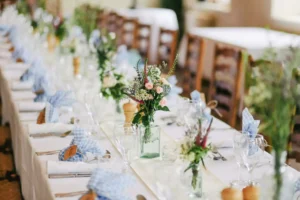It really was love at first sight.
David and Jonne spotted one another at church, while serving as volunteers for two different ministries in Jerusalem. David isn’t at all apologetic about what first attracted him to the dark-haired Dutch nurse: her beauty.
“It may not sound so spiritual,” he says, “but a real attraction is necessary and normal.” Jonne, in turn, was impressed with this tall, blond sailor from Sweden.
But David was hard to get to know. He was shy, yes — but also very careful in his relationships with women. Then a couple of his colleagues invited Jonne to a home prayer meeting David regularly attended, and they were able to meet and speak for the very first time.
“It took a lot of patience and prayer to become a couple,” Jonne says. Meanwhile, she observed David’s steady character and servant’s heart. She purposed to “pray and wait until the Lord had made it clear to me if David was the man God meant for me and I the wife that He meant for David.”
Though both had already considered cross-cultural marriage an option, David and Jonne’s attitude was, “Don’t underestimate it.” So they waited. They prayed. They were open with family and friends about their feelings. And in time they both became convinced that Jesus had brought them together.
With a yearlong engagement for ballast, they launched into married life. They had considered the fact that neither could speak the other’s mother tongue, and that one of them would always have to live away from family and home country. Still, moving to Sweden seemed exciting to Jonne. She’d had no problems living in Israel and expected the same from this new country.
But before Jonne could begin nursing in Sweden, she had to attend full-time language classes. Not being able to work was hard, both emotionally and financially. Though she picked up Swedish quickly, she still had difficulty finding the right words to express herself. She also had to deal with homesickness and adapting to another culture.
David and Jonne believe their marriage makes them more open-minded to other cultures and more understanding of how it would feel to be a refugee in a strange country. Their advice for couples considering cross-cultural marriage: “Talk beforehand about your expectations and fears. Be open to change and to give up a part of your own culture. Don’t think one country is better than the other, but try to find your own mix of both cultures. Create your own unique family culture.”
As David points out, your partner’s country of origin is not the main thing. Rather, “like in the story of Isaac and Jacob, the spouse must come from the father’s household, meaning your spouse must be a member of the household of God. If you have that as your foundation then your love will overcome all obstacles.”
Dan didn’t go to India to find a wife — but that’s where he found a woman of compassion, integrity and honest love. Culture seemed big — until he got to know her. Then it became quite decidedly secondary.
Two things lent strength to Dan and Pari’s eventual marriage. One, Dan had lived in India for a year, so he knew Pari’s culture well and could understand her struggles. Two, they had a long engagement — three years passed before Dan brought Pari home to America.
Even so, they have had their challenges. For Dan, it has been communication. Pari studied English for years, but because it’s hard to explain nuances and idioms, he can still say one thing and Pari hears something completely different. For instance, early in their marriage, he told her that “thanks” is less formal than “thank you.” Pari got offended when he said “thanks” to her. Why? She thought informal meant rude.
Pari wishes she had been more prepared for the culture shock. Before she arrived, she hadn’t even seen movies about America. There was so much to absorb all at once: the food, the clothing, the casual way men and women interact in the West and even the holiday traditions. She and Dan spent their first Thanksgiving in a restaurant, because she didn’t know anything about the American celebration.
Dan says the best advice they ever received came from a Western couple living in India, whom they visited as newlyweds. Noting that Dan was correcting Pari’s table manners, they told him, “Right now you don’t need to please anyone. You just need to please Parimala.” In other words, Dan didn’t need to rush his wife to conform to his culture.
Still, Pari was eager to learn and anxious not to be branded as new. Once they arrived in the United States, Dan arranged for her to be mentored weekly by a kind and godly older woman. He deliberately chose to live farther from work so she could be surrounded with good friends. Pari says, “He has made it very easy for me to live here. He doesn’t expect me to behave like an American woman. He makes me relaxed about how I do things.”
Dan says, “I value her Indianness — she’s very frugal. She says things in a straightforward way. She’s very free to talk to people about Christ.”
In Dan and Pari’s minds, they are not bringing up just Indian or American children. Valuing Indian focus on family needs and closeness, and American hard work, integrity, and ingenuity, they aim to add the strengths of both cultures to a biblical family framework.
“No way! She’s American.”
Lawrance had known several Americans for eight or nine years and was an English major in college, but the thought of marrying outside his Taiwanese culture had never crossed his mind. Besides, the girl in question was a teacher, deserving of his deep respect. But as their mutual friend pleaded with him to meet Amanda for coffee — just once — he finally relented.
By the time they met, Amanda had been heavily involved with Lawrance’s people, language and culture for more than 10 years and had been living in Taiwan for five. Her strong desire for marriage, coupled with the cross-cultural marriages she’d observed in Taiwan had made her more and more open to the idea — and when she discussed it with her parents and grandparents, she received the added benefit of their blessing.
Over coffee, Lawrance talked nearly nonstop, trying to convince Amanda that he wouldn’t work for her. His honesty and openness had the opposite effect: She was hooked! Lawrance immediately noticed she was different from other girls he had met. She didn’t want to date just for fun — but to discern if they could marry. In addition, their life goals matched.
During the next few months, they became students of each other, intentionally covering all the possible deal-breakers they could think of. Lawrance figured “it would be much easier to end the relationship at the beginning than hide things from each other only to exchange hearts and then later break them.” Instead, their love and confidence just kept right on growing.
Two weddings later (one on Texas and one in Taiwan), Amanda and Lawrance now teach English in Taiwan.
“Culture is a funny thing,” Amanda says. “There are things we can see — food, language, holidays and so on.” But like an iceberg, there is much more below the surface — honor-based culture vs. rule-based culture, for instance, or individualism vs. collectivism. These hidden things strongly affect “how we communicate and interact with the world around us.”
Their key challenge is communication. “Words carry different connotations in different cultures, and without meaning to, we hurt each other or have misunderstandings. And, while I’m sure this happens in all marriages, sometimes explaining why something hurt or why something doesn’t make sense to someone from another culture is really difficult because it can sound totally bizarre and irrational.”
Lawrance and Amanda have discovered that extended family may be welcoming, but not as culturally aware, or as willing to compromise as the couple themselves. “There may be expectations from extended family that can lead to stress and frustration, especially when the expectations are unspoken.” For example, Lawrance’s mother feels love when Amanda invites herself over, something that might have the opposite effect in America.
One of the couple’s most pressing daily challenges is what to eat. “While we both like the food from the other’s country and Lawrance has been very patient about trying my American cooking, it is sometimes really hard because we don’t share comfort foods,” Amanda says. “We both take turns compromising, and I’m trying to learn how to make my own version of American-Taiwanese food that can become new comfort food for us both.”
But some of their challenges are also their strengths. “Because we know we face cultural differences in communication styles and might encounter miscommunications due to speaking bilingually to each other, we are prepared to discuss things at length. It is often like a buffer for us,” Amanda says. “Before responding to what we hear, we will ask for clarification. This allows the other person to more fully explain their side or perspective. So, actually the awareness of our communication challenges helps us to be ‘quick to listen and slow to speak.’”
Lawrance and Amanda’s advice? “Because communication is so very important, language is key. We know that not all cross-cultural couples speak both languages and yet they have successful marriages. However, both of us strongly feel that it is essential for both the husband and the wife to learn their partner’s language as best as they can. Not being able to speak your heart language to the one who knows you most intimately is a huge disadvantage.”
Considering a mixed-culture marriage can be daunting, but in reality, every marriage should be entered “reverently, discreetly, advisedly, soberly, and in the fear of God.” What grounds and encourages these three couples is the same foundation on which we all build: the cross itself.
Lawrance and Amanda say, “When we have trouble agreeing on something or deciding which way something should be done, we can always depend on the truth of Scripture to inform our decisions.” Rather than an issue becoming an American or Taiwanese thing, “it becomes a biblical thing — and that is something that both of us can agree on easily.”
“We truly feel that because both of us are Christians and we both want to love and obey Jesus, our core values and beliefs are the same. Our faith in Christ allows us to become one because Christ transcends culture.”
Copyright 2010 Elisabeth Adams. All rights reserved.












